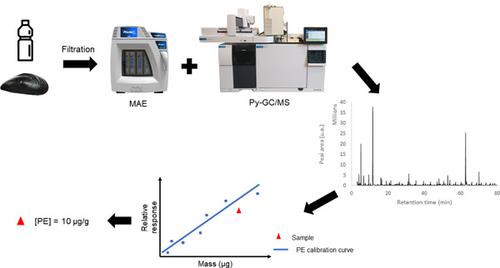当前位置:
X-MOL 学术
›
Environ. Toxicol. Chem.
›
论文详情
Our official English website, www.x-mol.net, welcomes your feedback! (Note: you will need to create a separate account there.)
Microwave-Assisted Extraction for Quantification of Microplastics Using Pyrolysis–Gas Chromatography/Mass Spectrometry
Environmental Toxicology and Chemistry ( IF 4.1 ) Pub Date : 2021-07-27 , DOI: 10.1002/etc.5179 Ludovic Hermabessiere 1 , Chelsea M Rochman 1
Environmental Toxicology and Chemistry ( IF 4.1 ) Pub Date : 2021-07-27 , DOI: 10.1002/etc.5179 Ludovic Hermabessiere 1 , Chelsea M Rochman 1
Affiliation

|
Microplastics are now recognized as a persistent and global pollutant. To quantitively measure microplastics in environmental matrices, several techniques are used including new methods using pyrolysis–gas chromatography/mass spectrometry (Py–GC/MS). In the present study, a new extraction method using microwave-assisted extraction (MAE) combined with Py–GC/MS was developed to extract and quantify a wide range of plastic polymers, and the method was validated using different environmental matrices. This new extraction method was able to extract polyethylene, polystyrene, polypropylene, poly(methyl-methacrylate) (PMMA), polyvinylchloride (PVC), and polycarbonate in dichloromethane with good recoveries (92.9–119.7%). The limit of detection and limit of quantification (LOQ) of the method ranged from 0.002 to 0.18 µg and from 1.2 to 5.8 µg, respectively. Intra- and interday repeatability values with coefficients of variation less than 25% for all polymers were obtained. Method validation also included a spike and recovery using all polymers from clean water, dirty water, and shrimp and salmon fillet samples, with recoveries of 85 to 111, 87 to 138, 81 to 122, and 50 to 151%, respectively. Finally, the method was tested on unspiked wild mussels and bottled water for proof-of-concept. Both polyethylene and PVC were detected and quantified in mussels, and polycarbonate and polypropylene were detected below the LOQ. For bottled water, polypropylene, polystyrene, and polycarbonate were all detected below the LOQ. We introduce a method combining MAE and Py–GC/MS as a tool for mass quantification of microplastics. This method can be used as a stand-alone, or as a complementary method to spectroscopic techniques. Environ Toxicol Chem 2021;40:2733–2741. © 2021 SETAC
中文翻译:

使用热解-气相色谱/质谱法对微塑料进行定量的微波辅助提取
微塑料现在被认为是一种持久性和全球性污染物。为了定量测量环境基质中的微塑料,使用了多种技术,包括使用热解-气相色谱/质谱 (Py-GC/MS) 的新方法。在本研究中,开发了一种使用微波辅助萃取 (MAE) 与 Py-GC/MS 相结合的新提取方法,用于提取和定量各种塑料聚合物,并使用不同的环境基质对该方法进行了验证。这种新的萃取方法能够在二氯甲烷中萃取聚乙烯、聚苯乙烯、聚丙烯、聚甲基丙烯酸甲酯 (PMMA)、聚氯乙烯 (PVC) 和聚碳酸酯,并且回收率很高 (92.9–119.7%)。该方法的检测限和定量限 (LOQ) 范围为 0.002 至 0.18 µg 和 1.2 至 5.8 µg,分别。获得了所有聚合物的变异系数小于 25% 的日内和日间重复性值。方法验证还包括使用清水、脏水、虾和鲑鱼鱼片样品中的所有聚合物进行加标和回收,回收率分别为 85% 到 111%、87% 到 138%、81% 到 122% 和 50% 到 151%。最后,该方法在未加标的野生贻贝和瓶装水上进行了测试,以进行概念验证。在贻贝中检测和量化了聚乙烯和 PVC,聚碳酸酯和聚丙烯检测到低于 LOQ。对于瓶装水,聚丙烯、聚苯乙烯和聚碳酸酯的检测均低于 LOQ。我们介绍了一种结合 MAE 和 Py-GC/MS 的方法,作为微塑料质量定量的工具。这种方法可以单独使用,环境毒物化学2021;40:2733–2741。© 2021 SETAC
更新日期:2021-09-29
中文翻译:

使用热解-气相色谱/质谱法对微塑料进行定量的微波辅助提取
微塑料现在被认为是一种持久性和全球性污染物。为了定量测量环境基质中的微塑料,使用了多种技术,包括使用热解-气相色谱/质谱 (Py-GC/MS) 的新方法。在本研究中,开发了一种使用微波辅助萃取 (MAE) 与 Py-GC/MS 相结合的新提取方法,用于提取和定量各种塑料聚合物,并使用不同的环境基质对该方法进行了验证。这种新的萃取方法能够在二氯甲烷中萃取聚乙烯、聚苯乙烯、聚丙烯、聚甲基丙烯酸甲酯 (PMMA)、聚氯乙烯 (PVC) 和聚碳酸酯,并且回收率很高 (92.9–119.7%)。该方法的检测限和定量限 (LOQ) 范围为 0.002 至 0.18 µg 和 1.2 至 5.8 µg,分别。获得了所有聚合物的变异系数小于 25% 的日内和日间重复性值。方法验证还包括使用清水、脏水、虾和鲑鱼鱼片样品中的所有聚合物进行加标和回收,回收率分别为 85% 到 111%、87% 到 138%、81% 到 122% 和 50% 到 151%。最后,该方法在未加标的野生贻贝和瓶装水上进行了测试,以进行概念验证。在贻贝中检测和量化了聚乙烯和 PVC,聚碳酸酯和聚丙烯检测到低于 LOQ。对于瓶装水,聚丙烯、聚苯乙烯和聚碳酸酯的检测均低于 LOQ。我们介绍了一种结合 MAE 和 Py-GC/MS 的方法,作为微塑料质量定量的工具。这种方法可以单独使用,环境毒物化学2021;40:2733–2741。© 2021 SETAC


























 京公网安备 11010802027423号
京公网安备 11010802027423号